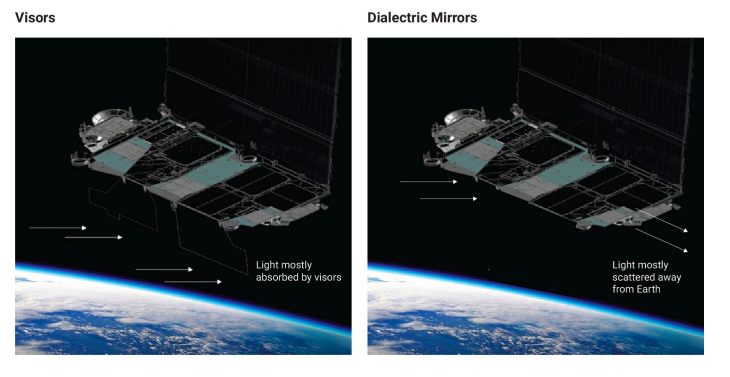
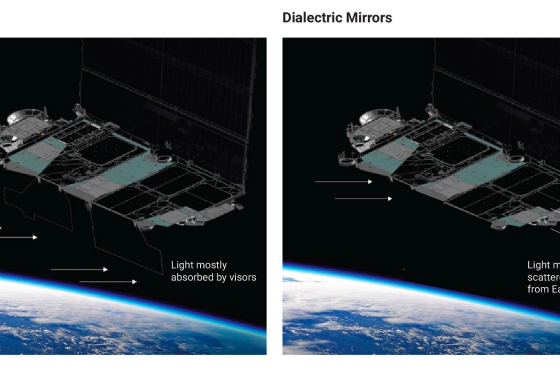
Space
SpaceX shares how it’s making Starlink satellites less bright.
SpaceX shared how it’s making its Starlink satellites less bright. The space exploration company published a document titled, Brightness Mitigation Best Practices for Satellite Operators that outlines how it’s working with the astronomy community to reduce light pollution.
New document from @SpaceX https://t.co/aI17WdaqrF
explaining what they have been doing to make their satellites less bright.
I applaud SpaceX for their work on this (and for making the document public), while remaining concerned to see how bright the Gen2 Starlinks end up being— Jonathan McDowell (@planet4589) July 29, 2022
SpaceX has been criticized for the brightness of its Starlink satellites by astronomers. Elon Musk and the team at SpaceX not only listened to the criticism but are actively responding to it by collaborating with the astronomy community to solve the issue.
SpaceX Is Making Starlink satellites Invisible to the naked eye.
SpaceX noted that through the collaboration, it has identified and mitigated the key causes of satellite brightness. The company is working on making the satellites invisible to the naked eye when they are at their standard operational altitude.
If satellites are illuminated by the sun at night, they can be visible to observers from the earth. However, the visibility of any satellite depends on the materials used for its surfaces.
Since satellites don’t emit their own light, the brightness results from natural sunlight scattering off of the satellites’ surfaces and reflecting down to earth. The light can scatter in two different ways: specular or diffuse.
SpaceX is focusing on specular scatter

SpaceX is investing in specular surfaces. Specular light is reflected at a single angle just like a mirror. Diffuse light reflects from many angles. The image above shows the difference between how specular light scatters and diffuse light scatters.
SpaceX noted that not all materials are highly reflective and some can be absorptive or make the light that is reflected much less bright.
SpaceX’s satellites are visible from the ground in two ways.
- Sunlight scatters off the main body.
- Sunlight scatters from the solar arrays.
To solve this, SpaceX adopted mitigations for both problems for its current, first-generation satellites.
Sun Visors and RF-Transparent mirror films

Sun Visors
For the first-gen satellites, SpaceX developed sun visors that block sunlight from hitting the bottom side of the chassis (body of the satellite.) They were made from materials that engineers developed to be invisible to radio frequencies.
However, the sun visors blocked the laser links that SpaceX uses to expand coverage to remote regions of the world. Additionally, the visors generated significant drag on the satellites. So, SpaceX determined that the sun visors weren’t a long-term solution.
RF- transparent mirror films.
SpaceX developed RF-transparent mirror films as an alternative to the sun visors. The film scatters most of the sunlight away from the Earth. SpaceX said that it has been improving its mirror films to scatter less light back to the earth.
It plans to deploy a new and improved version of the film on its next-generation satellites.
Inter-cell backing material
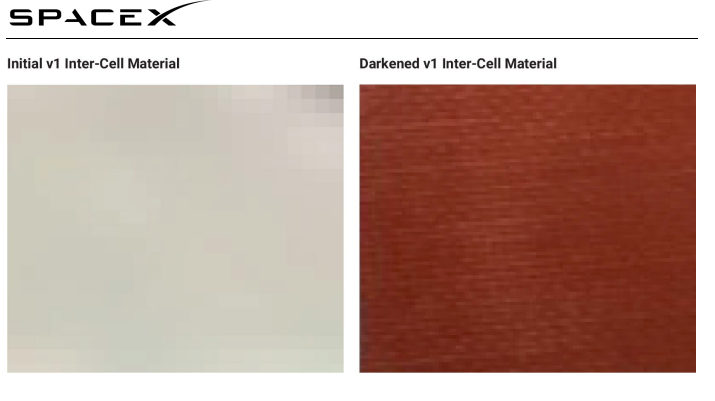
Another change that SpaceX made to its first-gen satellites involved the inter-cell backing material. The material was initially white but SpaceX changed it to a dark red that reduces the arrays’ brightness.
The downside is that the darkening of the material increases the temperature of the solar array which reduces performance. However, SpaceX will adopt many designs such as this one to reduce the brightness of the satellites.
Dielectric Mirror Film for Starlink satellites.
SpaceX noted that its second-gen satellite will add more capacity to the Starlink network; connecting more people in more places.
The second-gen satellites will use the following three advanced brightness techniques and I will dive into one of them: Dielectric Mirror film.
SpaceX will cover the bottom of the satellites with a second-gen dielectric mirror film. This version reduces the observed brightness ten times better than the first-gen film by using a Bi-Directional Reflectance Distribution Function (BRDF) metric.
You can see how the BRDF for decreases visibility in the chart below.
Credit: SpaceX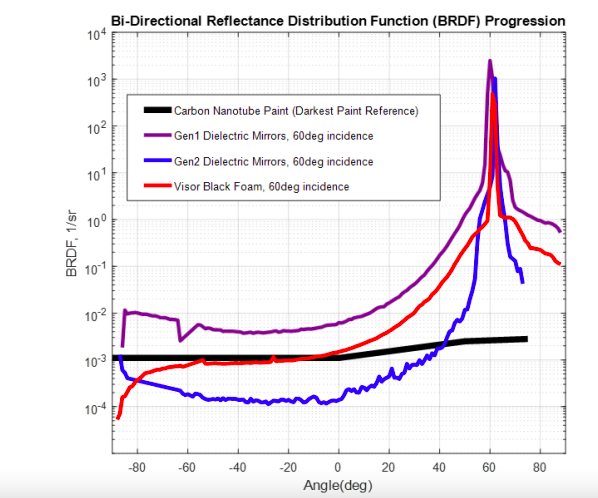
Through extensive research and iteration, SpaceX maximized the film’s specular scatter. The core of the film is a Bragg mirror that includes many thin layers of plastic that have a variety of refractive indices which create interference patterns internally to reflect the light.
It also allows radio waves to pass through with no issues. Protective layers of titanium dioxide and silicon dioxide were added to protect the film in thin, pure layers that don’t affect the film itself. Below is a comparison between the first-gen and second-gen mirrors.
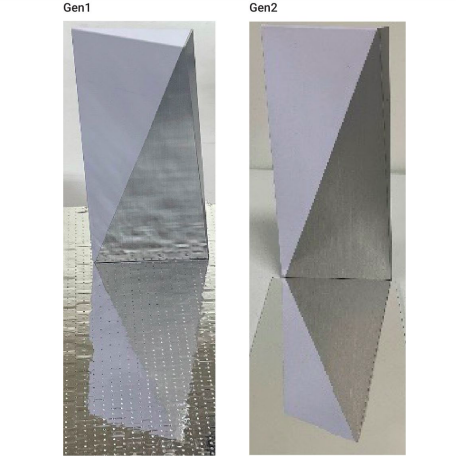
SpaceX plans to offer the dielectric mirror film as a product
SpaceX plans to offer the dielectric mirror film as a product on the Starlink website. The reason is that SpaceX can not reduce the effect of satellites on space exploration by itself.
The film will be offered at cost and all operators will be able to use it to reduce the effect of their own constellations.
SpaceX will continue to work with the astronomy community
SpaceX emphasized that not only is the astronomy community’s work important but that it would continue to work with them to reduce the effects of all satellite operations.
“SpaceX is committed to connecting as many people as possible through Starlink, improving the lives of millions of people here on Earth.”
“As a space exploration company, SpaceX is a strong supporter of astronomy and the scientific community.”
You can read the full document here.
I’d love to hear from you! If you have any comments, or concerns, see a typo, you can email me at johnna@teslarati.com. You can also reach me on Twitter @JohnnaCrider1

News
SpaceX shades airline for seeking contract with Amazon’s Starlink rival

SpaceX employees, including its CEO Elon Musk, shaded American Airlines on social media this past weekend due to the company’s reported talks with Amazon’s Starlink rival, Leo.
Starlink has been adopted by several airlines, including United Airlines, Qatar Airways, Hawaiian Airlines, WestJet, Air France, airBaltic, and others. It has gained notoriety as an extremely solid, dependable, and reliable option for airline travel, as traditional options frequently cause users to lose connection to the internet.
Many airlines have made the switch, while others continue to mull the options available to them. American Airlines is one of them.
A report from Bloomberg indicates the airline is thinking of going with a Starlink rival owned by Amazon, called Leo. It was previously referred to as Project Kuiper.
American CEO Robert Isom said (via Bloomberg):
“While there’s Starlink, there are other low-Earth-orbit satellite opportunities that we can look at. We’re making sure that American is going to have what our customers need.”
Isom also said American has been in touch with Amazon about installing Leo on its aircraft, but he would not reveal the status of any discussions with the company.
The report caught the attention of Michael Nicolls, the Vice President of Starlink Engineering at SpaceX, who said:
“Only fly on airlines with good connectivity… and only one source of good connectivity at the moment…”
CEO Elon Musk replied to Nicolls by stating that American Airlines risks losing “a lot of customers if their connectivity solution fails.”
American Airlines will lose a lot of customers if their connectivity solution fails
— Elon Musk (@elonmusk) December 14, 2025
There are over 8,000 Starlink satellites in orbit currently, offering internet coverage in over 150 countries and territories globally. SpaceX expands its array of satellites nearly every week with launches from California and Florida, aiming to offer internet access to everyone across the globe.
Currently, the company is focusing on expanding into new markets, such as Africa and Asia.
News
Tesla hints at Starlink integration with recent patent
“By employing polymer blends, some examples enable RF transmission from all the modules to satellites and other communication devices both inside and outside the vehicle.”

Tesla hinted at a potential Starlink internet terminal integration within its vehicles in a recent patent, which describes a vehicle roof assembly with integrated radio frequency (RF) transparency.
The patent, which is Pub. No U.S. 2025/0368267 describes a new vehicle roof that is made of RF-transparent polymer materials, allowing and “facilitating clear communication with external devices and satellites.”
Tesla believes that a new vehicle roof design, comprised of different materials than the standard metallic or glass elements used in cars today, would allow the company to integrate modern vehicular technologies, “particularly those requiring radio frequency transmission and reception.
Tesla has recently filed a US patent application on integrating RF transparent materials into the roof structure.
“facilitating clear communication with external devices and satellites”
Tesla fleet is getting @Starlink connectivity integration soon. LFG @Tesla @elonmusk… pic.twitter.com/bLa8YtPLd1
— Chansoo Byeon (@Chansoo) December 9, 2025
Instead of glass or metallic materials, Tesla says vehicles may benefit from high-strength polymer blends, such as Polycarbonate, Acrylonitrile Butadiene Styrene, or Acrylonitrile Styrene Acrylate.
These materials still provide ideal strength metrics for crashworthiness, stiffness for noise, vibration, and harshness control, and are compliant with head impact regulations.
They would also enable better performance with modern technologies, like internet terminals, which need an uninterrupted signal to satellites for maximum reception. Tesla writes in the patent:
“By employing polymer blends, some examples enable RF transmission from all the modules to satellites and other communication devices both inside and outside the vehicle.”

One of the challenges Tesla seems to be aware of with this type of roof design is the fact that it will still have to enable safety and keep that at the forefront of the design. As you can see in the illustration above, Tesla plans to use four layers to increase safety and rigidity, while also combating noise and vibration.
It notes in the patent that disclosed examples still meet the safety requirements outlined in the Federal Motor Vehicle Safety Standards (FMVSS).
Starlink integrated directly into Tesla vehicles would be a considerable advantage for owners. It would come with a handful of distinct advantages.
Initially, the inclusion of Starlink would completely eliminate cellular dead zones, something that is an issue, especially in rural areas. Starlink would provide connectivity in these remote regions and would ensure uninterrupted service during road trips and off-grid adventures.
It could also be a critical addition for Robotaxi, as it is crucial to have solid and reliable connectivity for remote monitoring and fleet management.
Starlink’s growing constellation, thanks to SpaceX’s routine and frequent launch schedule, will provide secure, stable, and reliable internet connectivity for Tesla vehicles.
Although many owners have already mounted Starlink Mini dishes under their glass roofs for a similar experience, it may be integrated directly into Teslas in the coming years, either as an upgrade or a standard feature.
Investor's Corner
SpaceX IPO is coming, CEO Elon Musk confirms
However, it appears Musk is ready for SpaceX to go public, as Ars Technica Senior Space Editor Eric Berger wrote an op-ed that indicated he thought SpaceX would go public soon. Musk replied, basically confirming it.

Elon Musk confirmed through a post on X that a SpaceX initial public offering (IPO) is on the way after hinting at it several times earlier this year.
It also comes one day after Bloomberg reported that SpaceX was aiming for a valuation of $1.5 trillion, adding that it wanted to raise $30 billion.
Musk has been transparent for most of the year that he wanted to try to figure out a way to get Tesla shareholders to invest in SpaceX, giving them access to the stock.
He has also recognized the issues of having a public stock, like litigation exposure, quarterly reporting pressures, and other inconveniences.
However, it appears Musk is ready for SpaceX to go public, as Ars Technica Senior Space Editor Eric Berger wrote an op-ed that indicated he thought SpaceX would go public soon.
Musk replied, basically confirming it:
As usual, Eric is accurate
— Elon Musk (@elonmusk) December 10, 2025
Berger believes the IPO would help support the need for $30 billion or more in capital needed to fund AI integration projects, such as space-based data centers and lunar satellite factories. Musk confirmed recently that SpaceX “will be doing” data centers in orbit.
AI appears to be a “key part” of SpaceX getting to Musk, Berger also wrote. When writing about whether or not Optimus is a viable project and product for the company, he says that none of that matters. Musk thinks it is, and that’s all that matters.
It seems like Musk has certainly mulled something this big for a very long time, and the idea of taking SpaceX public is not just likely; it is necessary for the company to get to Mars.
The details of when SpaceX will finally hit that public status are not known. Many of the reports that came out over the past few days indicate it would happen in 2026, so sooner rather than later.
But there are a lot of things on Musk’s plate early next year, especially with Cybercab production, the potential launch of Unsupervised Full Self-Driving, and the Roadster unveiling, all planned for Q1.








